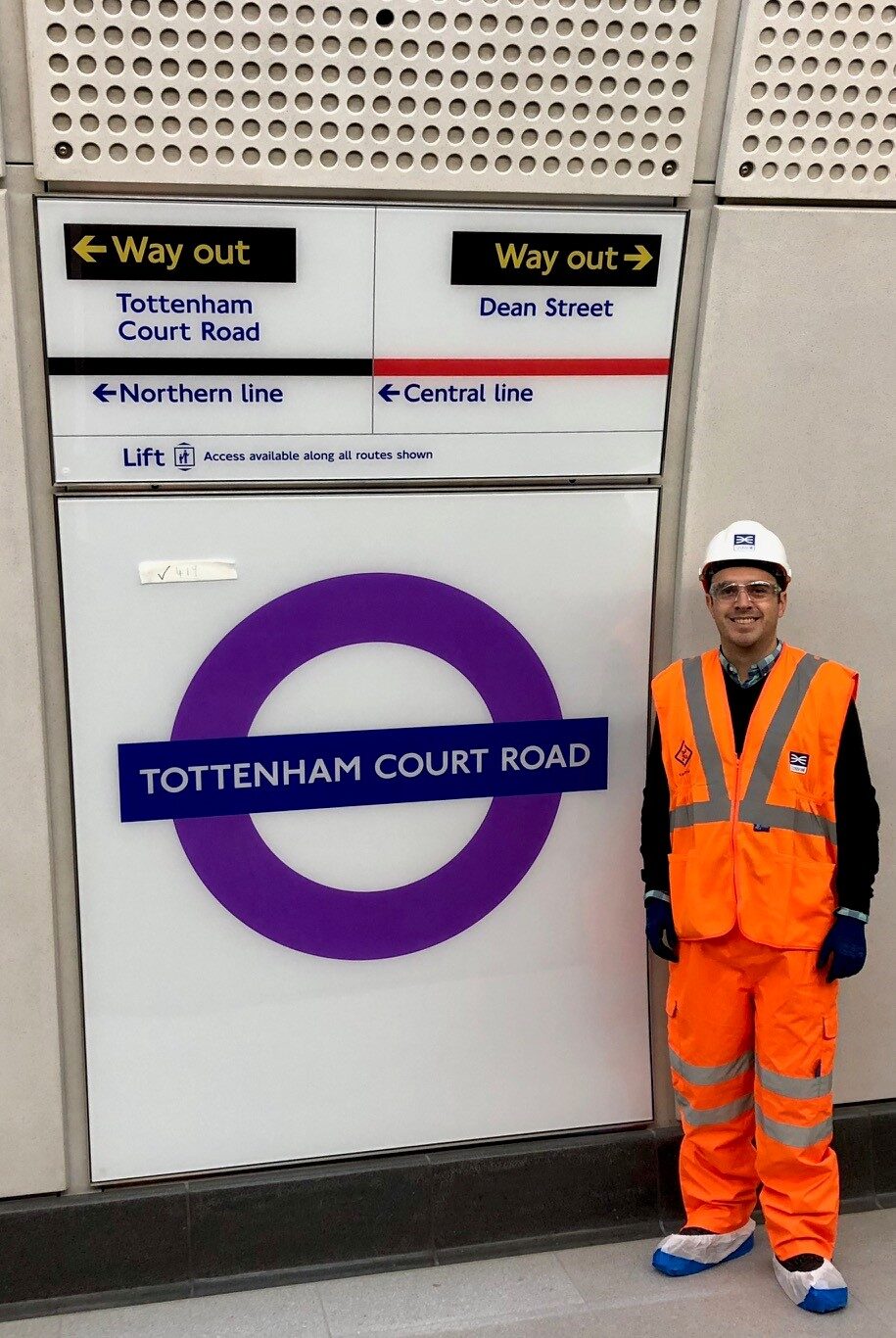Delivering value to our Clients – Jonathan Richardson’s Blog from his recent assignment with Crossrail
My current role with MCE is working with Sydney Metro as the Senior Design Manager on the Sydney Metro West project. Our business appreciated the general challenges associated with designing and constructing a new railway through the centre of Australia’s largest city. But also saw an opportunity through our network to benefit from lessons learnt by other cities. MCE invested in my time and flew me to London to meet senior members of Crossrail and really understand the complexities and challenges faced. These lessons learnt can then be discussed and adapted by Metro. Whilst in London I also attended part of the Global Engineering Conference and visited a fantastically complex project being delivered by contractor McGee in the heart of London.
At the core of our business MCE is passionate about engineering and delivering world class infrastructure efficiently for our clients and to create long lasting benefit to our community and society. This is a great example of an MCE initiative to create additional value to our clients.
Crossrail – Client Team Meeting, Site visit to Farringdon and Canary Wharf.
Whilst Sydney Metro West is in business case stage and Crossrail is nearing completion and operation, there are many similarities between the two projects. I was keen to meet with members of the team that had worked on the design and engineering aspects of the project to understand what had worked well for them and where challenges had arisen. It was a great opportunity to raise the profile of Engineering in Australia and discuss the great work we are doing in NSW.
I met with members of the Client team including Paul Dyson, Julian Robinson and Malcolm Taylor who showed me around Canary Wharf Station and discussed some of the intricacies of system integration, design packaging and design procurement. I also visited Farringdon’s Crossrail Station with James Gray where I met with the Station delivery team. We discussed a variety of challenges including the rollout of linewide common components (such as escalators and lifts) and supply chain issues. Crossrail faced similar issues to Sydney Metro relating to procurement program which led to the various Stations being delivered by different contractors and heavy involvement of the client team to coordinate this approach. There was myriad of challenges and lessons learnt that we discussed that MCE intend to potentially apply to the Sydney Metro program and suite of Stations
I also met with members of the Hawkins Brown architecture team including Harbinder Singh, Vivian Sin and Trent Sneddon. Hawkins Brown have worked on several the Crossrail project’s central section Stations for both client and contractor and we discussed matters such as the approvals regime for obtaining operator buy-in and acceptance for a new product and way of working, the challenges of successfully delivering over-Station development (OSD) and various mechanisms for design review.
We debated the benefits of delivering OSD concurrently with the Stations in major cities. Crossrail temporally disconnected these two components. We discussed the benefits of concurrent delivery of Station and OSD and whether it would deliver a more integrated systems with more transformational place-making outcomes. We talked about the challenges in design, packaging and delivery of these two very different yet intertwined pieces of infrastructure.
Ben Brouard and Kimberley Scott of Hawkins Brown showed me around Tottenham Court Road Crossrail Station to explain the complexities of integrating Stations of this scale into the heart London where the existing infrastructure constraints are onerous. We discussed that whilst components of the Crossrail Stations have a common design language, such as the glass-fibre reinforced concrete lining, these items were supplied, detailed and installed by multiple different manufacturers and hence each have slightly different access and maintenance requirements.
I met Mark Raiss of Aecom. Across a varied discussion, Mark and I deliberated the implications on designers of Crossrail’s design framework approach to delivering client design and then inheriting it when working with a contractor. Whilst complex, this led to some collaborative behaviours between client and designers and to designers undertaking checks of their competitors’ work.
Global Engineering Congress – 1 Great George Street, London.
MCE arranged for me to attend the Global Engineering Congress with my colleague Matthew Colton. The event was organised by Institution of Civil Engineers (ICE) and World Federation of Engineering Organsiations (WFEO). The Conference brought together thousands of engineers from around the world to London to share ideas of how to address the UN Sustainable Development Goals and deliver infrastructure more efficiently.
I attended several keynote and interactive sessions exploring varied topics;
- UNOPS, the United Nations Office for Project Services, newly launched report, Infrastructure: Underpinning Sustainable Development,has said that infrastructure workers need to stop thinking about development in terms of silos. Instead, the sector needs to realise that infrastructure is a cross-sector, integrated system of systems (made up of assets, knowledge and institutions), that can have an effect across generations.
- Shirley Rodrigues, Deputy Mayor for Environment and Energy at the Greater London Authority (GLA), revealed how London was becoming a more resilient and sustainable city. Amongst a broad ranging address, she highlighted initiatives including London’s Greener City Fund, which has set aside £12 million to improve the lives of residents – “for each pound spent on public green space, residents experience £27 of value. We want to make London cleaner and greener, and we know we need to involve our communities – we cannot forget the people. They know the problems where they live and often have really good ideas about possible solutions,” she said.
The congress was attended by engineers (and non-engineers) from a broad range of backgrounds and nationalities but it was fascinating to hear the commitment and variety of approaches to achieving the United Nations sustainable development goals. Of interest to me, given Sydney Metro West is at a very early stage of design, was a panel discussion on the challenges that uncertainty poses to our profession and projects and whether uncertainty is greater for our generation than for predecessors or if we just have a greater appreciation of it. One of the recommendations of this discussion was to embrace uncertainty rather than try to seek to overcome it and to consider the principles of recent forward-looking legislation, such as the Welsh governments Well-being of Future Generations (Wales) Act 2015, when developing major infrastructure projects.
Claridge’s Hotel, Mayfair site visit
I was invited by McGee Contractors to visit their project at Claridge’s hotel with operations director Seb Fossey. The contractor is delivering a multi-story basement beneath a fully operational hotel in the heart of London. The caissons used to construct this approx. 30m deep basement were dug by hand and the load of the hotel progressively transferred onto the columns new columns constructed within the caissons. A new lift shaft was also constructed by hand beneath the existing building in order to serve the new basement.
This project really demonstrates the impact of land value and how this can provide the remit for innovative thinking and project delivery to realise client aspirations; with the client unable to increase the height of the building and the extreme demand for additional hotel capacity combined with the value of land in this location, it becomes economically viable to larges parts of deliver a major subterranean structure by hand.
The new basement of Claridge’s Hotel showing the caissons installed in which to construct a new grid of columns to support the building above. With the columns complete and the load transferred to them, the caissons are being cut out and removed for the basement.
To summarise this was a very interesting trip which gave me the opportunity to really understand the challenges faced on similar international projects. It is a great example of MCE’s commitment to our team and clients. This investment will enable MCE and I to really help our clients deliver better infrastructure across Sydney Metro and other major Australian projects for the betterment of society.
Jonathan Richardson, Senior Associate Management • Commercial • Engineering
At the core of our business MCE is passionate about engineering and delivering world class infrastructure efficiently for our clients and to create long lasting benefit to our community and society.




